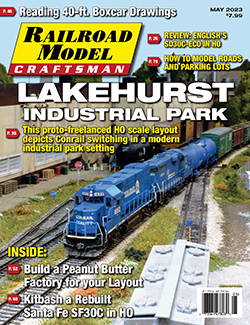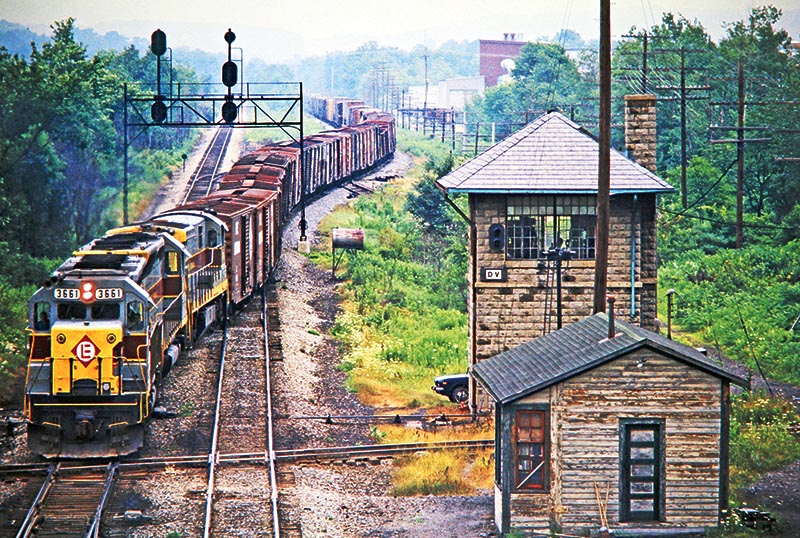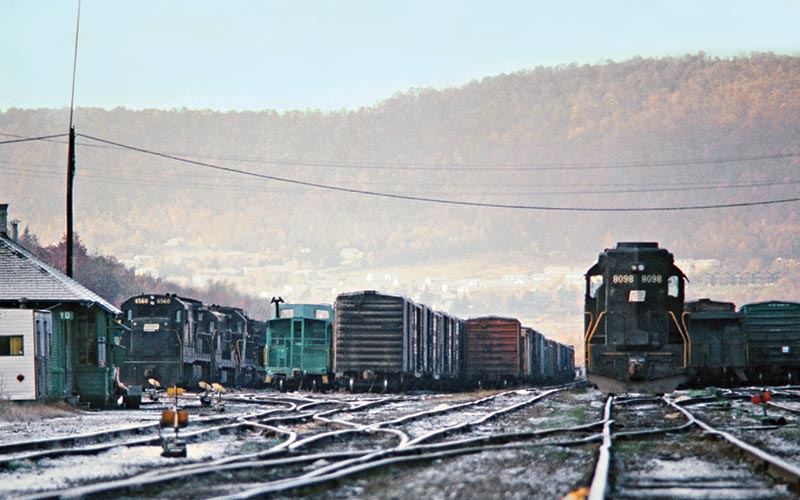 Standing derailments, missing freight cars, spoiled loads, broken windows, angry passengers, canceled trains, trash and vandalism, overgrown main lines on wobbly jointed rail, and shameful amounts of deferred maintenance. The 1960s were a tough time in American railroading. Why? Well, in World War Two, hundreds of thousands of citizen soldiers learned to drive 6×6 trucks and took that skill set home, becoming truckers. That, plus a new government-funded highway system and the rapid advance of commercial jet aviation, spelled doom for railroads as the 1950s came to a close.
Standing derailments, missing freight cars, spoiled loads, broken windows, angry passengers, canceled trains, trash and vandalism, overgrown main lines on wobbly jointed rail, and shameful amounts of deferred maintenance. The 1960s were a tough time in American railroading. Why? Well, in World War Two, hundreds of thousands of citizen soldiers learned to drive 6×6 trucks and took that skill set home, becoming truckers. That, plus a new government-funded highway system and the rapid advance of commercial jet aviation, spelled doom for railroads as the 1950s came to a close.
The 1960s could be considered the dawn of the “modern” era of railroading, but it wasn’t always sunny. It was, however, interesting, considering the juxtaposition between old and new. For example, regular revenue steam was still running in Mexico and even in a handful of operations in the U.S., while EMD was producing brand-new second-generation SD45s. Modern freight equipment like colorful new cushion-equipped hy-cube boxcars, billboard-covered hoppers, and intermodal trailers on 89-foot flats mingled with well-worn 40-foot steam era boxcars and a dwindling fleet of steel-braced, wooden freight cars from the 1920s. It all provides fantastic inspiration for model railroaders. And locomotives and freight cars aren’t the only things to consider.
Modeling passenger trains of that era is also a fun challenge. Combined City of Everywhere-type consists with three or four beat-up E-units hauling two dozen cars would be a spectacular contrast to the whittled-down regional passenger service that in many cases was a lone locomotive hauling a forlorn coach or combine. Commuter service could be modeled using worn-down 1920s heavyweight coaches or a single Budd Rail Diesel Car limping from station to station. Commuter parking lots filled with gleaming 1960s autos would provide a nice contrast to a railroad in decline.
It seems more people are now flocking to model the catastrophic failure that was the Penn Central, the 1968 combination of New York Central and Pennsylvania Railroad that went bankrupt just two years later. And it seems manufacturers are starting to catch on, with Rapido, Moloco, Tangent, Exactrail, and others putting out PC models perfect for this era. They’re even offering models of patched-over ex-Pennsy and NYC cars, something that was unheard of 20 years ago. Of course, the malaise of the era wasn’t just limited to Penn Central. Every railroad in America was going through the same period of belt-tightening, consolidation, and retreat in the face of stiff competition from trucking and the airlines.

ABOVE: Erie Lackawanna at Falconer, N.Y., July 20, 1975. —John F. Bjorklund photo, Courtesy Center for Railroad Photography & Art
But equipment and trains aren’t the only things to consider when tackling the “bad old days.” Remember, this was before the creation of the Environmental Protection Agency, so industrial areas were also at their polluted zenith. Try modeling Ohio’s Cuyahoga River industrial belt just after it caught fire (again), or oil spills, trashy billboards, illegally dumped mattresses and appliances in mired muck. How about modeling the debris after a block of warehouses goes up in flames, smoldering buildings and all? Pepper the layout with seedy-looking liquor stores, pawn shops, cheap hotels, and all-night diners, brought to life with some rough trade, activists, blue-collar workers off-shift, and people in period late-1960s attire. Remember, this isn’t Pleasantville (or even Plasticville!) anymore. Embrace the period films, music, and photography of the era to get the look just right. There’s so much high-quality photographic reference material available to us now that it’s easy to find inspiration in full color.
The clash of new and old continues with the wide variety of detailed vehicles being produced by Woodland Scenics, Rapido Trains, and others. Fill your streets with gleaming new muscle cars, delivery trucks, and station wagons, while old jalopies from the 1940s ply the same streets looking as if they’re on the way to the scrap yard. The same goes for buildings. Scratchbuild some 1960s “international” or “brutalist” style structures to act as counterpoint to the remodeled 19th and early 20th century storefront kits you know and love. Modeling closed businesses or demolished structures would also be a fun challenge as urban renewal takes hold trackside.
With so much texture to draw from, the possibilities of modeling the “bad old days” are endless. Let your imagination run wild and look beyond the perfectly mowed lawns and white picket fences. Make a gritty scene that Simon & Garfunkel would write a song about.
—Miles Callan



